|
Dynastie Borgia
"Église et pouvoir à la Renaissance"
Borgia Dynasty
"Church and
Power in the Renaissance" |
|
Raices & Memoria, vol.
X
Racines & Mémoire, Roots & Memory, vol. X |
|
Alia Vox AVSA9875
(A + B + C) & 1 DVD bonus
Code-barres/Barcode:
7619986398754 |
|
|
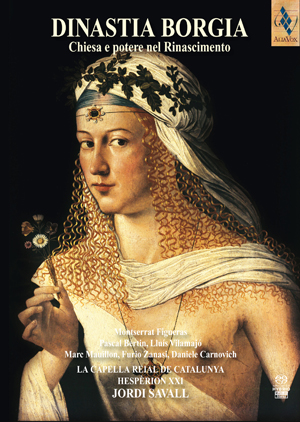
|
Description
Artistes / Performers :
Montserrat Figueras, Pascal Bertin, Luís
Vilamajó, Marc Mauillon, Furio Zanasi, Deniele Carnovich,
La Capella Reial de Catalunya,
Hespèrion XXI,
Dir. Jordi Savall
Lieu d'enregistrement / Recording site:
Collégiale du Château de Cardona (Catalogne / Catalunya)
Dates d'enregistrement:
1991-2009
Recording dates: 1991-2009
Durée totale / Total time: CD 1: 70':58, CD II:
75':54, CD III: 75':35

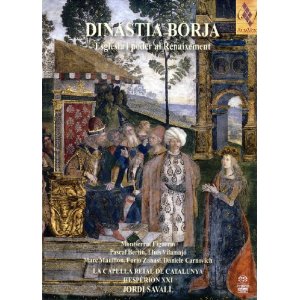
AVSA 9874 (a+b+C)
(Sans DVD / Without the DVD)
(Català/Valencia - Italiano - Castellano - English) |
|
|
 |
|
 La
célébration des 500 ans de la naissance de François Borgia (Gandie
1510 – Rome 1572), le dernier des membres illustres de la
« Dynastie Borgia », nous a motivés pour la réalisation de
ce projet historico-musical. Celui-ci est destiné à rappeler
les moments les plus significatifs de l’époque pendant
laquelle les principaux protagonistes de cette fascinante et
singulière famille ont vécu : Alphonse Borgia (Calixte III),
Rodrigue Borgia (Alexandre VI), Juan de Borja, César Borgia,
Lucrèce Borgia et François Borgia.
La
célébration des 500 ans de la naissance de François Borgia (Gandie
1510 – Rome 1572), le dernier des membres illustres de la
« Dynastie Borgia », nous a motivés pour la réalisation de
ce projet historico-musical. Celui-ci est destiné à rappeler
les moments les plus significatifs de l’époque pendant
laquelle les principaux protagonistes de cette fascinante et
singulière famille ont vécu : Alphonse Borgia (Calixte III),
Rodrigue Borgia (Alexandre VI), Juan de Borja, César Borgia,
Lucrèce Borgia et François Borgia.
JORDI SAVALL
Turin, 27 mai 2010
~~~~~~~~
 The celebration of the 500th
anniversary of the birth of St Francis Borgia (Gandia 1510 -
Rome 1572), the last of the illustrious members of the
“Borgia Dynasty,” prompted us to embark on the present
historical and musical project, recalling the most
significant events of the age in which the chief
protagonists of this extraordinary and fascinating family
lived: Alfonso de Borja (Callistus III), Rodrigo de Borja
(Alexander VI), Giovanni Borgia, Cesare Borgia, Lucrezia
Borgia and St Francis Borgia.
The celebration of the 500th
anniversary of the birth of St Francis Borgia (Gandia 1510 -
Rome 1572), the last of the illustrious members of the
“Borgia Dynasty,” prompted us to embark on the present
historical and musical project, recalling the most
significant events of the age in which the chief
protagonists of this extraordinary and fascinating family
lived: Alfonso de Borja (Callistus III), Rodrigo de Borja
(Alexander VI), Giovanni Borgia, Cesare Borgia, Lucrezia
Borgia and St Francis Borgia.
JORDI SAVALL
Turin, May 27,
2010
|
|
 Illustration de la pochette du disque:
Portrait de
Lucrèce Borgia par
Bartolomeo Veneto.
Illustration de la pochette du disque:
Portrait de
Lucrèce Borgia par
Bartolomeo Veneto.
L'oeuvre appartient au musée Städel de Francfort-sur-le-Main
(Allemagne) (voir
reproduction).
 Artwork of the CD jacket: Portrait of
Lucrezia Borgia by
Bartolomeo Veneto.
Artwork of the CD jacket: Portrait of
Lucrezia Borgia by
Bartolomeo Veneto.
This painting belongs to the Städel Museum in Frankfurt am Main (Germany)
(see
reproduction). |
|
Évaluations recensées / Reviews
located |
|

(02/2011)
(see below)
|

#
586 (12/2010)
(Voir ci-dessous) |

Fr./Eng.
|

Par: Matthias LangeMusikzen |
|

(34:4 -03-04/2011)
(see below) |

(02/2011) |

By: Steven Ritter
     |
Musikzen (01/2011)
 |

Andrew Clements (12/2010)
  |

Par: Jean-Noël Démard |

Par:
Camille de
Joyeuse |
|

La famille Borgia |

House of Borgia |
|
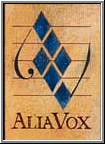
Extrait du livret / From the liner notes |
|
 DINASTIA BORGIA
DINASTIA BORGIA
Eglise
et Pouvoir à la Renaissance
Comme dans les précédents
projets de Livre/CD, nous avons divisé les différentes
étapes de la « Dynastie Borgia » en sept chapitres qui vont
de la Valence musulmane du XIIIe siècle jusqu’à la
canonisation de François Borgia en 1671.
La 1ère Partie traite de :
Les chemins vers le pouvoir : origines et expansion d’une
dynastie. 1238 – 1492
(CD 1) I. Origines et progression de la famille Borja
II. Final des trois cultures et conquête du pouvoir. Le
Vatican.
La 2ème Partie se centre sur les années de la papauté
d’Alexandre VI :
(CD 2) Supremus est mortalibus : Comble et fin d’un rêve.
1492 – 1509
III. Comble et fin d’un rêve
IV. Temps de révoltes et d’humanisme.
Et la 3ème Partie est le passage :
(CD 3) Du règne convulsif d’Alexandre VI au triomphe
spirituel de François Borgia.
1671
V. Batailles et trêves : responsabilités militaires et
politiques.
VI. Renoncements et transformation spirituelle.
VII. Dernières années et mort de François Borgia. Sa
canonisation.
Cet ample parcours historique nous permet de montrer la
richesse musicale de l’environnement des Borgia et de leur
temps, avec les musiques les plus représentatives provenant
des chansonniers de Montecassino, Palacio, Duque de Calabria
et Gandia. Ces œuvres sont signées des plus grands
compositeurs hispaniques (Johannes Cornago, Cristóbal de
Morales, Lluis del Milà, Bartomeu Cárceres, Mateo Flecha et
Joan Cabanilles, incluant le Credo de la Messe attribuée à
François Borgia lui-même, comme exemple d’un art plus
populaire). Elles sont aussi signées par des compositeurs
européens de la même époque (Gilles Binchois, Guillaume
Dufay, Josquin des Prez, Henrich Isaac, Claude Goudimel). Ce
sont souvent des œuvres composées pour une occasion
concrète, pour célébrer une victoire, une bataille ou une
trêve, pour le couronnement d’Alexandre VI ou pour déplorer
la mort d’un personnage important (Johannes Ockeghem,
Laurent le Magnifique ou l’Empereur Maximilien…) Cette
fresque musicale est complétée par des textes récités : des
témoignages poétiques, des éloges, des critiques, y compris
le terrible ban d’expulsion des Maures de 1609.
La beauté et l’émotion de ces musiques donnent une nouvelle
vie aux moments phares d’une époque convulsive et
extraordinaire et nous rapprochent d’une façon plus
objective et émouvante de la réalité sociale et culturelle
du temps de la Dynastie des Borgia.
JORDI SAVALL
Turin, 27 mai 2010 Traduction : Irène Bloc
Poursuivez votre lecture - texte intégral
AVSA9875 :
Cliquez ici
~~~~
 DINASTIA BORGIA
DINASTIA BORGIA
Church
and Power in the Renaissance
As in our previous CD-book projects, we have divided the
various stages of the “Borgia Dynasty” into seven chapters,
from 13th Century Muslim Valencia to the death and
canonization of Francis Borgia in 1671.
Part I deals with
(CD 1) Paths to power: the origins and expansion of a
dynasty. 1238 – 1492
I. The origins and rise of the Borgia family
II. The demise of the Spain of the Three Cultures and the
conquest of power: the Vatican
Part II focuses on the years of the reign of Pope Alexander
VI;
(CD 2) Supremus est mortalibus: The culmination and end of a
dream. 1492 – 1509
III. The culmination and end of a dream
IV. The age of upheavals and humanism
And Part III deals with the passage from
(CD 3) The turbulent “reign” of Alexander VI to the
spiritual triumph of St Francis Borgia. 1510 – 1671
V. Battles and truces: military and political responsibilities
VI. Renunciation and spiritual transformation
VII. Final years, death and canonization of Francis Borgia
This broad historical sweep allows us to demonstrate the
musical richness surrounding the Borgias and their period
through a selection of the most representative works from
the Cancionero de Montecassino, Cancionero de Palacio,
Cancionero del Duque de Calabria and Cancionero de Gandía.
Written by the greatest Hispanic composers of the age
(Johannes Cornago, Cristóbal de Morales, Lluís del Milà,
Bartomeu Cárceres, Mateo Flecha and Joan Cabanilles,
including the Credo from the Mass attributed to St Francis
Borgia himself, as an example of a more popular musical
style), as well as those written by their European
contemporaries (Gilles Binchois, Guillaume Dufay, Josquin
des Prez, Heinrich Isaac, Claude Goudimel), in many cases to
mark a specific occasion, such as the celebration of a
military victory, a battle or a truce, or the coronation of
Pope Alexander VI, or to lament the death of outstanding
figures such as Johannes Ockeghem, Lorenzo the Magnificent
and Emperor Maximilian, etc. The musical programme is
complemented by the recitation of a number of poetic
testimonies, eulogies and critical accounts, including the
terrible decree of the expulsion of the Moriscos in 1609.
The beauty and the emotion of this music brings some key
moments of that convulsed and extraordinary period back to
life, offering us a thrilling and, at the same time, a more
objective view of the social and cultural context of the age
of the Borgia Dynasty.
JORDI SAVALL
Turino,
27th May 2010
Translated by Jacqueline Minett
Read on - Full text
AV98SA9875:
Click here
|
|
Gramophone-
(02/2011)
|
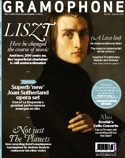
|
Subscription
Abonnement |
Reviewer: Julie
Anne Sadie
- Full text |
|
Excerpt:
“One
might expect that, with the Borgias, all roads would lead to Rome,
but in this case most lead back to Catalonia...Savall's own
presence, as both leader and principal viol player, can always be
felt. His string, wind, brass and percussion players are
superb...His wife, the soprano Montserrat Figueras, makes
beautifully positioned cameo appearances on each disc.
Hats off!” |
THE TIMES
LONDON - 11th DECEMBER 2010 |
|
|
“The musical legacy
of the Borgia dynasty? Some mistake, surely — aren’t this family of
kings and popes renowned for their poisonings and unfettered sex?
...In another of his history spectaculars, Savall and his devoted
musicians go beneath the headlines...This collection is a treasure
chest and the performances are blissfully vivid.” |
|
Diapason- # 586
(12/2010)
|
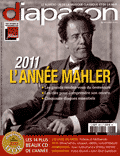 |
Appréciation

Evaluation |
Abonnement
Subscription |
|
Analyste: Roger
Tellart
Extraits:
"Condenser en trois CD la tumultueuse chronique
des Borgia relève de l'exploit. Et l'aventure s'avère passionnante,
avec, en toile de fond tout le gotha (ou presque du concert
occidental, de la Chapelle de Bourgogne, via Dufay et Binchois, aux
polyphonistes majeurs de l'école franco-flamande et espagnole."
"Jordi Savall, pour cette évocation richement documentée, associe
aux musiciens réguliers d'Hespèrion XXI le petit ensemble des
sympathisants (grecs, arméniens, marocains, israéliens ...) venus
d'une Méditerranée toujours plus complice. Les humeurs pluralistes
s'épanouissent. Et les grands moments d'émotion polyphonique ne
manquent pas - saluons la ferveur de l'Exultet caelum cum
laudibus du Cancionero de Montecassino comme l'affliction montée
du Lamento pour la mort de Laurent le Magnifique d'Heinrich
Isaac." |
Reviewer: Roger
Tellart
Abridged version :
»To be able to
condense into three CDs the tumultuous chronicle of the Borgia
family is quite a feat. And the adventure turns out to be
fascinating, with, as a background, just about every composer from
the western world, starting with the Chapel of Burgundy, via Dufay
and Binchois, up to the major polyphonists from the Franco-Flemish
and Spanish school.”
”For this evocative demonstration, sumptuously documented, Savall
adds to the regular forces of Hespèrion XXI a group of friends
(Greeks, Armenians, Moroccans, Israelites …) coming from the
Mediterranean region. The result is a rich variety of sounds. Great
moments of emotion are achieved – let us salute the intensity of the
Exultet caelum cum laudibus from the Cancionero de
Montecassino as well as the affliction from the Lamento for the
death of Lorenzo the Magnificent by Heinrich Isaac.”
Translation by: Classicalacarte.net
|
|
Classica- # 128
(12/2010 - 01/2012)
|
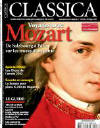 |
Appréciation:

Evaluation:
|
Abonnement
Subscription |
Analyste: Non précisé
La revue "Classica" attribue un  sans autre précision, dans le cadre d'un article "fourre-tout"
intitulé "Des cadeaux pour les fêtes" (de fin d'année 2010).
sans autre précision, dans le cadre d'un article "fourre-tout"
intitulé "Des cadeaux pour les fêtes" (de fin d'année 2010).
|
|

02-2011 |
|
Appréciation
~~~~~
Evaluation |
|
Reviewer:
Excerpt :
“The spicy family saga allows Jordi
Savall the freedom to evoke a vibrant and eclectic soundscape...Savall
animates the whole to fine effect, drawing performances which range
from the poetic to the bellicose...an impressive musical journey which
enhances our understanding of a powerful clan and its enduring
cultural impact.”
Full text
|
|

34:4 (03/04-2011)
|
 |
Abonnement
Subscription |
Reviewer: J. F.
Weber
Excerpts :
“The title,
The Borgia Dynasty, celebrates the family from Valencia that is
at the center, as the subtitle puts it, of « Church and power in the
Renaissance”…
”Savall collects a broad selection of musical works to mark these
two centuries. (i.e. 15th and 16th c.) There
are more familiar composers represented here than in previous books
of the series. Among pieces worth mentioning are Isaac’s Quis
dabit capiti meo aquam, a first recording of Mabrianus Orto’s
Salve Regis Mater, and several Josquin motets. Most of the
program was recorded a year ago*, but Savall judiciously
incorporated excerpts from several earlier issues. The notes
acknowledge Isabel I Reina de Castilla (29:1) for the
anonymous “Exultet caelum” and Cornago’s “Patres nostris”; Carlos
V (24:4) for Morales’s “Jubilate Deo”; but do not acknowledge
the slightly earlier Alfons V el Magnànim (25:2) for
the anonymous “Correno multi cani” and some small excerpts or (sic)
El Cant de Sibilla (23:1) for the Valencia version of that
song, the longest of these reissued pieces. There are several tracks
of narration divided among four speakers; some selections of
sephardic, Moorish, and
Turkish music; and a variety of performers alternating among vocal
ensemble, instrumental ensemble, and solo (notably Andrew
Lawrence-King’s harp).”
”The effect of almost a four-hour program of such variety depends on
your willingness to immerse yourself in the book.”
””The performances are uniformly excellent, as expected of these
ensembles. It is worth emphasizing the beauty of the production, a
solidly bound hardcover book that makes an impressive gift.”
* (Sept., Oct. & Nov. 2009)
This article is
available on the web to
subscribers of Fanfare. |
|
| |
Autres références disponibles via la base de
données de Todd McComb/ Other available references via
Todd McComb's database:
(Site: http://www.medieval.org)
Re:
|
|
|
|
|
To order / Commander
Alia Vox AVSA9875
Code-barres/Barcode
:
7619986398754
|
|
La viole de
gambe
Parutions
récentes |
Viola da gamba
Recent
releases |











